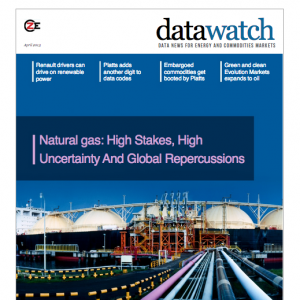 Graphs and charts are useful and efficient communication tools that condense a large amount of data into something digestible. As a business analyst for a company that specializes in enterprise data management for energy and commodities, it’s important I have the right tools to work with when creating accurate charts and graphs to present my findings.
Graphs and charts are useful and efficient communication tools that condense a large amount of data into something digestible. As a business analyst for a company that specializes in enterprise data management for energy and commodities, it’s important I have the right tools to work with when creating accurate charts and graphs to present my findings.
Take for example I want to get a spark spread (the marginal profitability) of a natural gas-fired power plant and use this information to create a graph and chart. I need to get data for electricity, the natural gas price and the heat rate.
To do this I pull reports from a commodities exchange for electricity prices and natural gas prices. I also need to find a heat rate from a reliable source.
Using this data I can create the metric or spark spread, which I can then display on a line graph using graphing software.
Sounds simple?
Well yes and no.
Graphing and charting can be a cumbersome process. Following the process above step-by-step may seem easy, but this isn’t really the case.
Data collection is usually the hardest part of the process. Data can be scattered in various data sources and formats or it can have restricted access. It might not even exist. One of the terms we throw around a bit at work, is ’Data Mess’.
Analytics however can be really complex. To reduce repetitive work and create simpler analytics I often use formulas. Formulas house logic and calculations which can be called upon when needed; as long as you have access the resources needed for this process. Anyone can use formulas with a little bit of knowledge. I think this is a great feature of formulas as they empower users with the ability to get results without having to know all the details.
Tools Can Help
For the last few months I’ve been working with our company’s suite of data management software products known collectively as the ZEMA Suite. The latest version – ZEMA 4 – has brought with it a slew of graphing enhancements. There are now double the graphing options available and a new and friendly user interface. I can select how to graph my data and colors easily, and can have multiple types of graphs overlaid if I need them.
On the analytic side of things, ZEMA 4 has a lot of features to offer. There is a host of formulas covering a variety of areas including data aggregation, gap filling, calculating implied volatilities of option contracts, and trend analysis. I believe people who work with time series data will find ZEMA especially useful.
Going back to my earlier example of spark spread calculation. With ZEMA, it takes me just few clicks to run the analysis:
1) Select the power price source
2) Select the natural gas price source
3) Retrieve the pre-built spark spread formula
4) Enter the heat rate
And my graph is created in minutes:
The core functionality of ZEMA as I see it is its ability to clean up the Data Mess. ZEMA can automate the data collection process, validate the data, standardize the format, apply a meta-data layer for searching, and automate some analytics on that data, pushing it into a downstream system. I said earlier that obtaining data can be the hardest part and I see every day how ZEMA helps people get their data.
Visit our website to learn more about the ZEMA Suite and how it can help you create more accurate and detailed charts and graphs using formulas.





